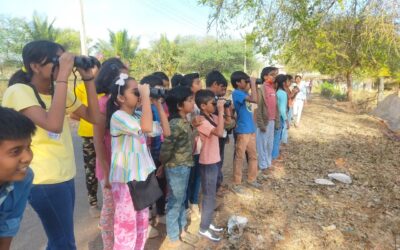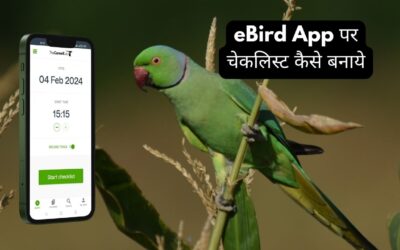State forest departments across India are increasingly conducting bird surveys or bird counts through volunteers. A variety of methods are in use and many of them use eBird as a backbone for ease of data collection, curation, quality control and analysis. However, there is no clearly defined standardised methodology that can be used in a wide range of landscapes. In this blog, we document a few different options for possible survey protocols, together with their costs and benefits. If survey organisers would like to explore in more detail, please contact Bird Count India to discuss further specifics of possible methodology and analysis.
Surveying forests need special consideration because of:
- Higher bird diversity in general
- Diversity in habitats and terrains
- Limitations in access and camping
- Limited availability of skilled volunteers (particularly with knowledge of calls as sight detections in dense forests are relatively low)
- Reporting requirements for Forest Departments
Some common standards to be followed irrespective of specific methodology:
- Ensure the survey is spread across the entire target area; only then can results be cautiously generalised to the overall area
- It is crucial to identify skilled birders, and form small survey teams, each with at least one such expert
- Insist on reporting all species in each eBird list (i.e. complete lists)
- Fix a standard duration of every checklist (e.g. 15 minutes)
- Keep bird monitoring time limited to hours of highest bird activity (typically early morning & late evening)
- Insist on entering the bird data while in the field using eBird Mobile App (avoids incorrect post-facto GPS fixes)
- Detection can be via sight or call – as long as the species is confidently identified
- Birds flying over the habitat should also be included in the checklist. Breeding code “F” (=Flyover) may be used.
- Include counts (or estimates of flocks) in eBird lists. Avoid “X”.
- Limit volunteers from embarking on single-species target searches (or waits)
Option 1: Blind, equal-duration lists
In this simplest of methods, volunteers submit as many constant duration (e.g. 15 minutes) travelling or stationary complete lists within the target area during the survey duration. They may use pre-existing trails and multiple teams could possibly cover the same trail at different periods of time. Pooling all these lists will provide the reporting frequency of all the birds seen during the survey period. This works well when the habitat is generally uniform and access to different parts of the target area are easy. However, this method fails in heterogeneous habitats, because it results in over-representation of habitats close to camps/roads.
Option 2: Habitat segregated equal-duration listing
In this method, coordinators pre-identify the main habitats/altitudes and demarcate the habitats/altitudes into zones. This will avoid lists that span multiple habitats. Different teams are deployed into these zones with the sole focus of covering those habitats/altitudes through trails. The actual listing is no different from Option 1 while the teams being confined to the zones allotted to them. This works well for small target areas with reasonably diverse habitats (e.g. a forested campus) where access and skilled volunteers are not an issue. The sheer number of zone-specific checklists submitted during the survey would be sufficient to do any post-processing by converting them into equal/proportional effort surveys (with randomisation).
Option 3: Stratification/Gridding and equal effort listing
In this method, the entire target area is overlaid over constant size grids (e.g. 3 x 3 sq. km.) to cover the area uniformly. Grids on the boundary may be surveyed or ignored based on how much of the grid has the target area. In each grid, a single trail is identified (e.g. using Google Earth) of typically 2-4 km and the trail is divided into constant-sized segments (e.g. 200 or 400m). There is no golden rule on how long the trail will have to be and how long each segment should be – this depends on the habitat, access and walkability of the trails. If one is not able to find a sufficiently long trail in a grid, then multiple trails may be used as an exception. Once fixed, the length of the trail and consequently the number of segments in each grid will be exactly the same, providing an equal effort listing. Each trail is assigned a team and the team generates a bird list in each segment for a fixed duration (e.g. 15 minutes), covering the segment. E.g. If 200m is the segment and the trail is for 2km, the team surveys birds for 2 hours resulting in 8 complete checklists.
The same trail should be covered in both morning and evening sessions and repeated on multiple days so that there are enough replicates. The analysis is done by the coordinators at the grid level while the birders focus on the trails they are assigned. This method is suited for long-term monitoring where different organisations or teams can take up survey coordination each year as long as the same trails are covered every time at a well-documented pace.
Each segment should have a unique number – e.g. T12-7 (7th segment in the trail of the 12th grid). This must be entered in the comments section of each eBird checklist in the exact prescribed format. Coordinators filter the data for these comments to segregate the lists for each segment. Alternatively, a google form could be used by the participants to enter the list link for every segment.
See here the report on Kanha Bird Survey conducted in Madhya Pradesh in 2017.
Option 4: Stratification/Gridding, Randomisation, and equal effort listing
This is a step forward from the Stratification/Gridding in Option 3, where the segments are now randomly chosen. Hence, all available trails in a grid are segmented and a random selection of a subset of the segments are used for the actual survey. Long-term monitoring should stick to the same randomly chosen segments every year/season and should not rerandomize them. This is suited when the volunteer strength is high as segments randomly chosen can be far apart and different teams may be needed to cover them. However, this is the most robust design and it should be attempted where the resources are available. Long-term monitoring projects using this option should be extra careful as they need to guarantee the same resource strength for every iteration of the survey. Segment naming would be slightly more involved – e.g. T12-3-5 (5th segment in the 3rd trail of the 12th grid).
To know how to analyse your survey outputs, wait for our next post !
Useful tips & techniques:
Create a group account: It is highly recommended to create a new group account in eBird for the specific survey. All volunteers must be instructed to share all their lists with this eBird account. Survey coordinators get a single handle to download all the data from this group account at any time during the survey.
Create trip report: Creating a trip report at the start of the survey and adding the lead birders of each transect to them would be a good idea. As and when the checklists are submitted, they automatically get reflected in the trip report. Forest Departments will be able to use this trip report link for answering quick questions from higher officials or press. Birders themselves can see what others saw during the survey as soon as the lists are submitted.
Gridding softwares: Gridding can be done in multiple ways – there is a small tool created for gridding any shape/kml file (See:https://birdcountindia.shinyapps.io/Atlas_Grid_Generator/). This was done with a bird atlas in mind, but can be used for forest surveys as well by choosing grids, quadrants or subcells – as deemed fit for the survey at hand (sampling can be ignored). These files can be downloaded as kml files to be opened in apps like Google Maps/Google Earth
Special considerations:
Handling wetlands inside forests: Some of the assumptions about trails and segments will fail when large wetlands are encountered inside forest areas. For systematic long-term monitoring, it is preferred to count wetland birds as a total count (like in Asian Waterbirds Census) during one of the survey days. The number of teams required to do that same may vary based on the wetland size. These wetland checklists may not be combined with segment checklists for frequency analysis – however, they will contribute to the total checklist apart from having a specific table with waterbird counts.
Handling nocturnal birds: The general survey pattern will not be able to cover nocturnal birds – an important component of forested habitats. Without adding any complexity, teams may be requested to spend time in late evenings listening to calls in an adjacent trail and make 15-minute nocturnal lists. This will ensure the species coverage is complete; however more focussed, resource-intensive methods are required to obtain a reliable abundance index of nocturnal birds.
Point counts: Certain surveys employ point counts of a trail. In general, trail counts are more natural for citizen scientists as it closely matches the way they would be generally birding. However, all the different options discussed are also applicable for point counts, except that the distance between each point needs to be pre-fixed.
Using Distance bands: Formal scientific monitoring often uses distances of birds from the transect line to estimate true density. However, it is generally not recommended to use distance bands (with range finder device) in citizen-lead bird surveys due to the increased training effort for volunteers and increased complexity of data collection – both of which can affect the motivation of participants as well as accuracy of data collection. However, in case this method is used, please be aware that we need different tools to record the distance of every bird on the trail (i.e. eBird App has no means to record the distance of each bird from the trail).
Entering birds outside the trail (or while not birding): For a total checklist of the region, all this information is valuable. While birding outside the survey trail, it is recommended to submit complete checklists with the same fixed duration. While not birding, please submit them as incidental checklists. All these checklists must be shared with the group account.
Handling non-bird data: Certain forest departments would like to collect some ancillary data as well during the bird survey (e.g. presence of large animals). In such cases, this information could either be noted down separately for each segment in a field notebook or entered as comments in the eBird checklist. However, for compilation – volunteers should enter this information on a separate google form created for this specific purpose.
Pilot surveys: While options (1) and (2) are straightforward, the other two may turn out to be more complicated. It is recommended to do a pilot survey to standardise an acceptable distance for a trail and segment as well as understand accessibility challenges for the trails in remote grids.
Header Image: Changeable Hawk-Eagle Nisaetus cirrhatus © Abhishek Das/ Macaulay Library





Very good
Excellent information.
Are there any guidelines on surveys using sound/call records and analysis of calls